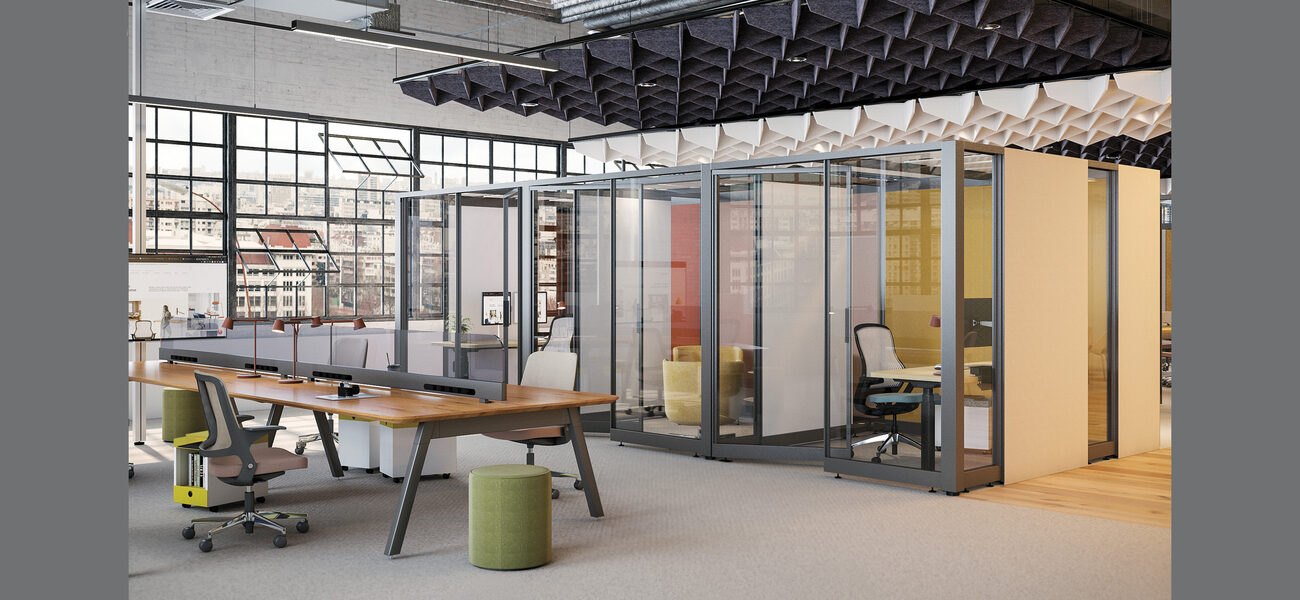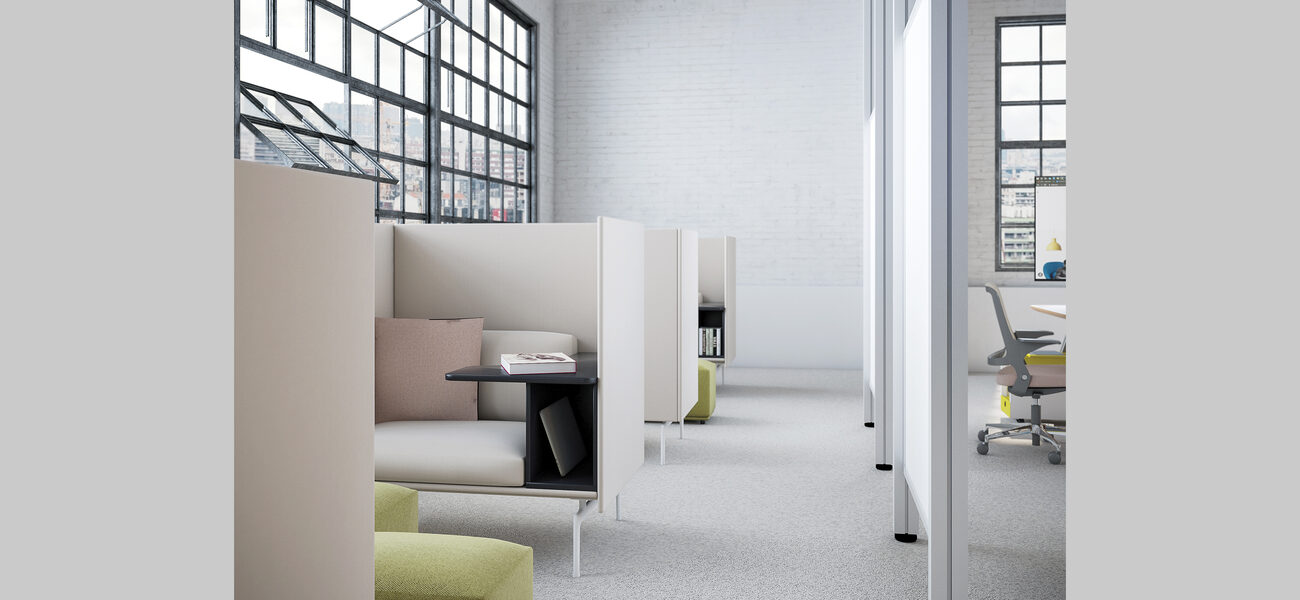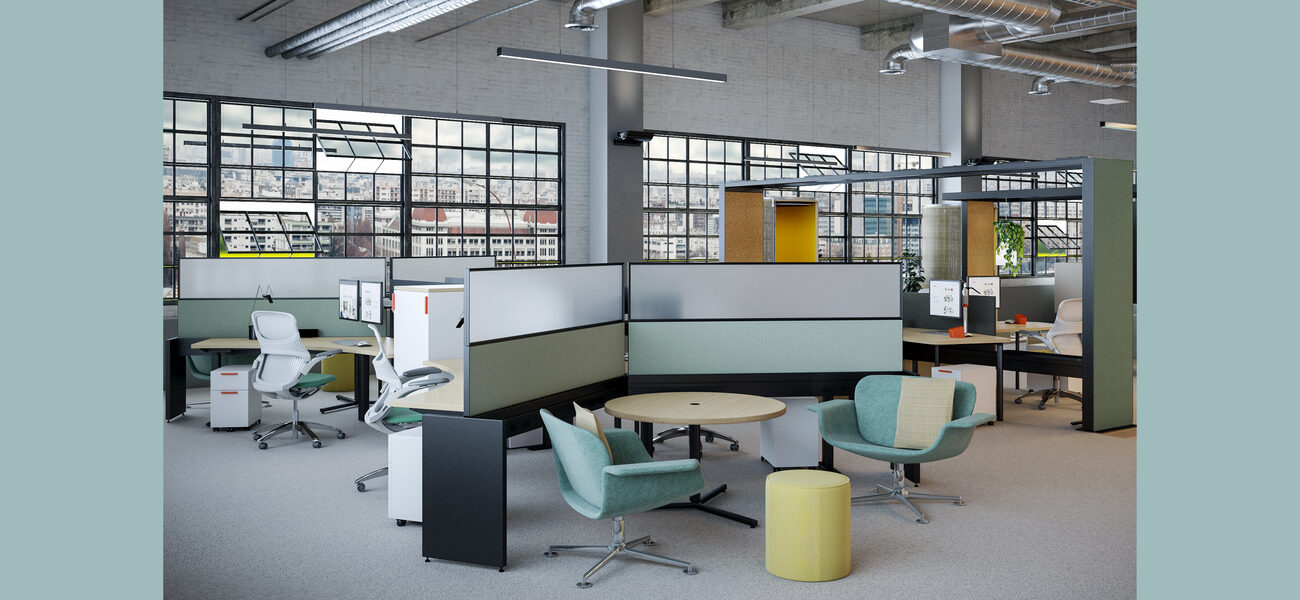While the global pandemic changed many fundamental elements of daily life—including travel, education, and the economy—its impact on the workplace will perhaps prove to be the most disruptive and long-lasting. Research conducted by MillerKnoll reveals how years of remote working, empty real estate, workforce redistribution, and limited social interaction have profoundly changed workplace expectations and organizational strategies for employees and employers alike. The research study, called The Case for a Thriving Workplace, indicates a massive shift in future planning approaches to workspace design and organizational structure that are more human, holistic, interactive, and flexible.
To gather data for the study, MillerKnoll hosted over 20 targeted panel discussions with more than 50 industry experts in architecture and design, human resources, higher education, real estate, government, technology, healthcare, and wellness. Another 300 workplace leaders also participated in a series of 30 roundtables discussing current and emerging trends. Additionally, an online survey was conducted with 81 workplace executives across a diverse range of industries about their workplace practices pre- and post-Covid to gain a deeper understanding of how organizations intend to plan their space and support their workers in the future.
“We are entering an age where work is no longer about where we go; it is about what we do,” says Carolyn Cirillo, Applied Insights and Knowledge at MillerKnoll. “It’s transforming into this concept of the workplace as an ecosystem, not just a place. Also, it is the voice of the worker we are hearing loud and clear in this moment. The worker, not the organization, is driving what is needed in the post-Covid workplace.”
Results from the study suggest that remote work will continue to play a significant role beyond the pandemic, and that there will be a major shift away from individual office workspaces towards providing more collaborative meeting spaces, outdoor spaces, and social areas with an emphasis on people-focused environments. It is expected that the average percentage of unassigned workspaces will more than double, while the percentage of assigned workspaces will drop by a third. This means that space reservation and occupancy-sensing technologies will become more important for supporting a highly mobile workforce. Use of shared/coworking spaces and “space-as-a-service” will also grow, as organizations look to reduce their managed workspace footprint and increase future flexibility.
“One thing that was clear from our survey findings is that the next generation of workplaces is going to be about bringing people together. Covid didn’t end the office as we know it, but we are going to be returning to a very different place. When employees return to the future office, it will primarily be for creative group interactions like brainstorming, problem solving, idea exchange, socialization, learning, and knowledge sharing,” says Cirillo.
People-Focused Priorities
Study participants were asked to select the two most important business drivers of their post-Covid workplace strategy. Not surprisingly, strategies highlighting flexibility and business continuity represented more than 30 percent of the responses, with several respondents noting the need for higher levels of flexibility with a mix of spaces that are collaborative, engaging, and aesthetically appealing. The survey also found that a majority of organizations hoped to lower their managed workplace footprint as working from home becomes more normative. Nearly two-thirds of the participants predicted “some to a significant” decrease in the square footage of their managed workplace portfolio, and nearly half of the participants felt there was going to be a shift in the design of their spaces toward a more casual look and feel within the next 18 to 24 months.
One of the more surprising findings was that 60 percent of participants chose drivers concerning people-related considerations like supporting workforce performance and engagement, stress reduction, worker wellbeing, knowledge networks, and creating a sense of social cohesion.
“People-focused issues are by far the strongest drivers of this emerging strategy. We think this more human-centered approach is inevitable because we’ve all looked into our clients’ and coworkers’ bedrooms. We’ve seen their living rooms, we’ve seen their kids, their pets, and their spouses. We are seeing sides of them we never saw before. And this is driving us towards a more human-focused workplace that supports the whole person,” says Cirillo.
Creating a Workplace Ecosystem
One thing the pandemic demonstrated was that many aspects of daily work can be efficiently done remotely. In fact, working remotely from a home office was widely rated as superior for tasks that require a high level of individual focus and attention. More than 76 percent of study participants rated the ability to concentrate as the most successful aspect of working from home. Consequently, remote working will continue to be a significant part of the post-pandemic workplace ecosystem. Approximately 30 percent of study participants predict that their employees will continue to work remotely at least one or two days a week, while about 25 percent predict that their employees will work remotely three or four days a week, and 14 percent intend to go fully remote.
That said, participants gave remote work very low ratings when it comes to doing creative group work, brainstorming, team collaboration, and supporting social networking and company culture. Brainstorming was rated as “limited to not successful” by 46 percent of study participants and 62 percent gave the same negative rating for socializing and community building.
“This data provides factual evidence for what many employers, organizations, and leaders suspected—that the home office is a great place for doing efficient solo work, but it is not great for deep ideation and scrum work, and it falls far short when it comes to building community, professional networks, and social interactions,” says Cirillo.
This hybrid combination of workstyles and their respective space requirements means that everywhere must be supported as a potential work point, whether it’s the headquarters, a satellite office, a home office, or a coworking space. All of these spaces are now part of the modern workplace ecosystem, and they all require different types of support.
Evolving Workspaces
One of the biggest impacts remote working will have on the post-Covid era is that employers are expecting to make significant changes to their proportions of individual and group workspace. On average, organizations are predicting about a 22 percent decrease in individual workspaces, with a 45 percent increase in the amount of group space.
“This insight intrigued us quite a bit, so we sliced and diced the data a few different ways. The first thing we did was to explore how company size impacted this shift. We found that all companies, regardless of size, forecast a decrease in individual workspace and an increase in group space, but it was most significant with large companies—companies with 150,000 people or more. They are the ones who are planning the largest decreases in individual workspaces, which is around 30 percent. Then we looked at it by culture. While culture might have been a significant driver in the allocation of individual to group spaces in the past, there will be a roughly equal balance of individual and collaborative workspaces in the post-Covid workplace regardless of the culture,” says Cirillo.
When participants were asked to assess their anticipated changes to different types of workspaces over the next 18 to 24 months, more than 60 percent predicted an increase in the number of meeting spaces, and more than 50 percent expect an increase in social interaction spaces, while nearly 40 percent also predicted an increase in outdoor spaces. Almost half of the participants reported that their primary emphasis is on supporting interactive collaborative work like idea creation, scrum events, and brainstorming.
“This means that the new workplace ecosystem needs to have areas for small teams to come together to build things. It needs spaces for groups to ideate and exchange new ideas. It needs places for teams to gather together to learn and problem-solve. And it needs breakout spaces for individuals to pause and study away from the larger group for whatever reason. We have a shorthand for this we call BIGS: build, ideate, gather, and study,” says Cirillo.
Organizations are expected to forgo the large open office space designs that became the norm of the past decade in exchange for smaller, more human-centric environments with casual, comfortable furnishings, textured walls, and acoustic-mitigation materials like thick felt curtains and workstation dividers. The post-Covid workplace will also see a significant increase in unassigned workspace and hot desking. Before the pandemic, study participants reported an average allocation of about 80 percent assigned workspaces to 20 percent unassigned spaces. But over the next two years, organizations are expecting to shift to an average of 55 percent assigned with 45 percent unassigned.
“We looked at this data related to company size, too, and found that the larger the organization, the more likely they are to increase use of unassigned space,” says Cirillo.
Additionally, organizations anticipate an average sharing ratio of about one space to three people for individual workspaces, including workstations, desks, and individual refuge rooms.
“Paired with our other data, these results reflect an evolving belief that the fundamental purpose of the office is changing, and that more activities are going to occur in these group and social spaces. We anticipate that employees will mostly be using unassigned individual spaces for short-term tasks like meeting preparation, doing follow-ups, writing emails, or conducting phone calls between meetings,” says Cirillo.
As organizations adapt to the new workplace as a diverse hybrid ecosystem, there will also be an increased need to implement space reservation and occupancy sensing technologies that can help them manage a more mobile, flexible workforce. Approximately 70 percent of study participants who were not already using these types of technologies say they are considering implementing them within the next two years.
Space as a Service
Another growing post-Covid trend is an increase in the “space as a service” model, which includes flexible satellite offices and coworking spaces like WeWork and others.
“Right now, only about a third of study participants are using alternative workplace models, but another third or so predict that they’re going to increase the use of this type of space over the next two years. The flex industry got a pretty big boost from the General Services Administration—which is the biggest tenant in the world, with 700 million sf in their portfolio—after they awarded a $50 million contract to five flexible space operators and aggregators. To us, that is a significant endorsement of the viability of this model. It fits the uncertainty everyone will be dealing with going forward. Nobody wants to take on a 10-year lease anymore, but a one-year membership at a coworking space is a lot easier to digest,” says Cirillo.
Looking Forward – The Thriving Workplace
The results of the study make it clear that the pandemic has significantly disrupted how organizations and employees think of their workplace in unexpected ways. Work is now organized around what people do, as opposed to where they are. Moving forward, companies will need to support every place in the hybrid workplace ecosystem—whether it’s the headquarters, a home office, a satellite office, or a coworking space. More importantly, people-focused drivers now dominate the direction of workplace and organizational planning strategies.
“Our research suggests that we are on the brink of truly transformative change. We’ve learned that people don’t want to merely survive post-pandemic. They want to thrive. In many ways, the disruptive changes we’ve experienced are opportunities to create new approaches to workspace that support the whole person and improve our daily experiences through meaningful engagement. We call this new model the Thriving Workplace, and it promises to be more alive and resilient than ever,” says Cirillo.
By Johnathon Allen



